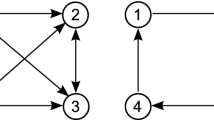Abstract
We consider the OK Corral model formulated by Williams and McIlroy(11) and later studied by Kingman.(7) In this paper we refine some of Kingman's results, by showing the connection between this model and Friedman's urn, and using Rubin's construction to decouple the urn. Also we obtain the exact expression for the probability of survival of exactly S gunmen given an initially fair configuration.
Similar content being viewed by others
Change history
10 June 2019
In this note we acknowledge a mistake made in Section 6 of��KV, for the exact probability for the number of survivors in the OK Corral model, given near the bottom of page 275.
10 June 2019
In this note we acknowledge a mistake made in Section 6 of��KV, for the exact probability for the number of survivors in the OK Corral model, given near the bottom of page 275.
10 June 2019
In this note we acknowledge a mistake made in Section 6 of��KV, for the exact probability for the number of survivors in the OK Corral model, given near the bottom of page 275.
REFERENCES
Athreya, K., and Karlin, S. (1968). Embedding of urn schemes into continuous time Markov branching process and related limit theorems. Ann. Math. Statist. 39, 1801–1817.
Billingsley, P. (1985). Probability and Measure, 2nd. edn., Wiley, New York.
Davis, B. (1990). Reinforced random walk. Probab. Theory Related Fields 84, 203–229.
Freedman, D. (1965). Bernard Friedman's urn. Ann. Math. Statist. 36, 956–970.
Friedman, B. (1949). A simple urn model. Comm. Pure Appl. Math. 2, 59–70.
Khanin, K., and Khanin, R. (2001). A probabilistic model for establishing of neuron polarity. J. Math. Biol. 42, 26–40.
Kingman, J. F. C. (1999). Martingales in the OK Corral. Bull. London Math. Soc. 31, 601–606.
Limic, V. (2001). Attracting edge property for a class of reinforced random walks. preprint.
Petrov, V. V. (1975). Sums of Independent Random Variables, 2nd. edn., Springer, Berlin.
Sellke, T. (1994). Reinforced Random Walk on the d-Dimensional Integer Lattice, Department of Statistics, Purdue University, Technical report #94–26.
Williams, D., and McIlroy, P. (1998). The OK Corral and the power of the law (a curious Poisson kernel formula for a parabolic equation). Bull. London Math. Soc. 30, 166–170.
Rights and permissions
About this article
Cite this article
Kingman, J.F.C., Volkov, S.E. Solution to the OK Corral Model via Decoupling of Friedman's Urn. Journal of Theoretical Probability 16, 267–276 (2003). https://doi.org/10.1023/A:1022294908268
Issue Date:
DOI: https://doi.org/10.1023/A:1022294908268




